Cieszyn-Silesian 作者: 来源: 发布时间:2021-10-27
Ⅰ. Population and Area
Area
• Total 28.69 km2 (11.08 sq mi)
Population (2019-06-30[1])
• Total 34,513
• Density 1,200/km2 (3,100/sq mi)
Website http://www.cieszyn.pl/
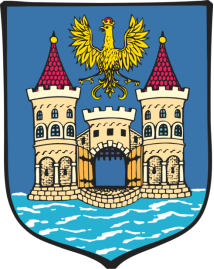
Ⅱ.Natural Geography (environment and resources)
-The town is situated on the Olza river, a tributary of the Oder River, which forms the border with the Czech Republic. It is located within the western Silesian Foothills north of the Silesian Beskids and Mt. Czantoria Wielka, a popular ski resort. Cieszyn is the heart of the historical region of Cieszyn Silesia, the southeasternmost part of Upper Silesia. Until the end of World War I in 1918 it was a seat of the Dukes of Teschen.
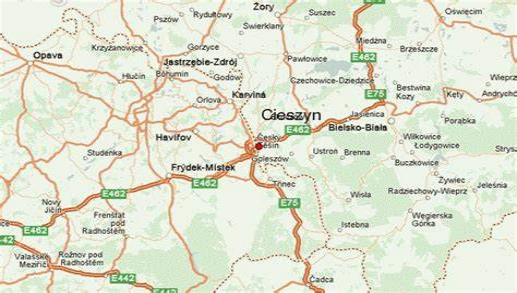
-In 1920 Cieszyn Silesia was divided between the two newly created states of Poland and Czechoslovakia, with the smaller western suburbs of Teschen becoming part of Czechoslovakia as a new town called Český Těšín. The larger part of the town joined Poland as Cieszyn. Three bridges connect the twin towns. After Poland and the Czech Republic joined the European Union and its passport-free Schengen zone, border controls were abolished and residents of both the Polish and Czech part could move freely across the border. The combined population of Polish and Czech parts of the city is 61,201 inhabitants. Cieszyn is the southern terminus of the Polish National road 1 leading to Gdańsk on the Baltic coast.
-The town combines both Polish and Old–Austrian peculiarities in the style of its buildings. Because of several major fires and subsequent reconstructions (the last one in the late 18th century), the picturesque old town is sometimes called Little Vienna. The only relic of the ancient castle is a square tower, dating from the 14th century and 11th century romanesque chapel.
-Transport
-Road traffic
-The Polish national road 1 , which leads to Gdansk (part of the European route 75 ), and the S1 expressway , which leads to Krakow , begin in Cieszyn . The provincial road 938 leads from Cieszyn to Pawłowice and is the shortest route from Cieszyn to the Upper Silesian industrial area . Local roads lead to Skoczów , Ustroń , Dębowciec and Leszna Górna . Due to the increasing number of cars in the city center, parking within the city center has been made chargeable.
-Local public transport
-Tram traffic was stopped at the beginning of the 20th century. There is a network of city bus connections, the hub of which is the main train station. The connections lead to the nearby villages, including Hażlach , Pogwizdów , Kaczyce and Gumna .
-Omnibus
-Numerous private bus companies operate in Cieszyn, offering connections to the nearby towns and villages, as well as Kraków , Katowice , Krosno , Bielsko-Biała , Jastrzębie-Zdrój , Gliwice and Wrocław .
-Railway
-In 1869, Teschen received a train station on the Kaschau-Oderberger Bahn , which is now on Czech territory. With the construction of the Moravian-Silesian city railway, Teschen became a railway junction in 1888.
Ⅲ.Economy
-Cieszyn won an award in the Great League Table of Towns and Cities 2003, as the best medium-sized county town in the Province of Silesia. Among 314 county towns Cieszyn was the fifth town in the premiership of Polish towns and cities. It’s a town with resourceful, socially active residents, a well-developed business sector, good municipal infrastructure and good living conditions.
-In Cieszyn, a historical town situated on the Polish-Czech border, a new institution is being created – one which is vital for Silesia. It is called the Silesian Castle of Art and Enterprise.
-Employment and unemployment
-For many years Cieszyn has provided employment for several thousand inhabitants of Śląsk Cieszyn. According to studies that have been carried out about 40% of Cieszyn employees commute to work from neighboring parishes. The greatest number of job in Cieszyn are provided in the following areas: industry, construction, trade, public administration, health care, and education.
-In the 1990's a major change in the employment structure occurred. The number of jobs in factories dropped severely but, at the same time, the number of units providing services (both material and non-material) increased.
-Unemployment did not spare Cieszyn. In the late 1990's the unemployment rate was 5-6%. Now it has increased to more than 10%.
-Detailed data concerning employment and unemployment are provided in the “Cieszyn in Numbers” publication which is updated every year.
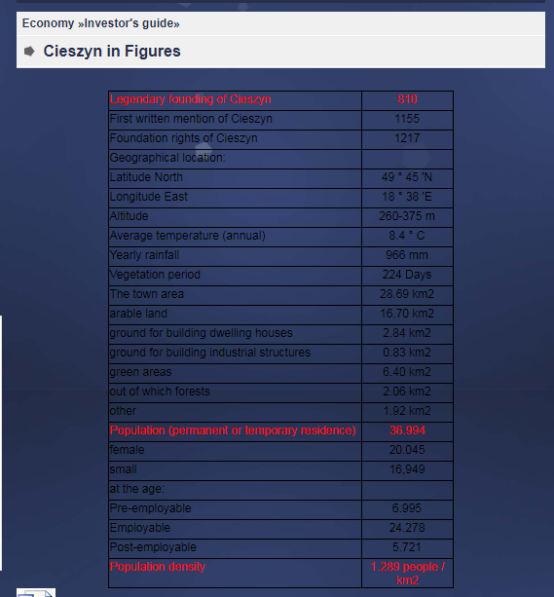
-http://www.cieszyn.pl/?p=categoriesShow&iCategory=573
-Business environment
-Telecommunication
-In Cieszyn there are two cable networks: Polish Telecommunication SA and DIALOG SA Telephony. Through their digital centrals they ensure high quality services, which include automatic phone connections with the whole world.
-Transmitting stations, located in Cieszyn, ensure connections through mobile telephone networks. They are: Era GSM, GSM Plus and IDEA.
-Internet
-Telekomunikacja Polska SA (Polish Telecommunication SA) and Telefonia DIALOG (DIALOG SA Telephony) provide the full range of internet services through their telecommunication networks. There are also two private providers ofinternet services. They are: ATA Commerce and IQNet.
-Banks
-In Cieszyn there are branches of 10 banks:
-- Bank Handlowy SA, 27 Bobrecka St., tel. (48-33) 851 26 00
-- Bank Przemysłowo - Handlowy PBK SA, 20 Rynek, tel. (48-33) 851 21 38
-- Bank Spółdzielczy, 4 Kochanowskiego St., tel. (48-33) 851 28 26
-Bank Zachodni WBK SA, 14 Rynek, tel. (48-33) 851 56 66
-Górnośląski Bank Gospodarczy SA, 13 Stary Targ, tel. (48-33) 851 87 70
-ING Bank Śląski SA, 1 Mennicza St., tel. (48-33) 851 15 43
-Kredyt Bank PBI SA, 4 Stary Targ, tel. (48-33) 851 08 20
-Millenium Big Bank Gdański SA, 11 Rynek, tel. (48-33 ) 851 36 10
-Bank Pekao SA, 2 Sejmowa St., tel. (48-33) 851 49 37
-PKO Bank Polski SA, 25 Kolejowa St., tel. (48-33) 852 54 91
-The most important industrial plants
-All the most important manufacturing enterprises located in Cieszyn are privately owned, foreign capital included. These are:
-POLIFARB Cieszyn - Wrocław SA (paints and varnishes) (the foreign capital: SIGMAKALON with headquarters in Paris, France)
-KRAFT FOODS Polska Sp. z oo (Ltd.), "Olza" branch ("Prince Polo" wafers, "Milka" chocolate) (the foreign capital: KRAFT FOODS INTERNATIONAL with headquarters in New York, USA)
-"Electric Machines - CELMA" SA (asynchronous electric engines, iron casting) (the foreign capital: INTERELEKTRA POLAND I with headquarters in Warsaw - a joint stock company with Italian and Luxemburg capital)
-“ELEKTROMETAL” SA (telephone and teletype appliances for the mining industry)
-“FACH” SA (a broad range of automatic cooling systems for refrigerators and air-conditioning).
-"LAKMA" SA (paints, glues, household chemicals)
-"MIROMETR" Sp. z oo (liquid flow meters) (the foreign capital: SAPPEL with headquarters in Saint Louis, France)
-Municipal management
-The town is equipped with a sewage system that carries waste to the municipal treatment plant. At present more than 63% of households utilize the municipal plant. There are plans to connect further areas of the town in the nearest future. Both the sewage network and the purification plant are run by a municipal organizational unit, Zakład Gospodarki Komunalnej. The water supply network in the town has reserves and belongs to Wodociągi Ziem Cieszyńskiej, Sp. z oo (Ziemia Cieszyńska Water Ltd.) with its base in Ustroń. WZC is an inter-parish company in which Cieszyn plays a substantial role.
-Also in the town there is a central-heating plant, Energetyka Cieszyńska, with its heating source (the heating power is about 150 MW and electric power - 4.5MW) and heating networks of 90 km in length. The heating plant provides the heat by means of water either at a stable temperature of 130 C or at variable temperatures from 130 to 70 C. The reserve of the heating power at its source is about 30 MW.
-The natural-gas network is administered by Zakład Gazowniczy in Zabrze, Distribution Station (Distribution Station) in Cieszyn. There are also reserves in networks.
-The Electric Power station networks are run by Energetyka Beskidzka, Zakład Energetyczny, Cieszyn.
-The town has a resolved plan for supplying the town with heat, electricity and gas which includes connections to ground for industrial buildings, domestic housing and municipal investments.
-http://www.cieszyn.pl/?p=categoriesShow&iCategory=1013
Ⅳ.Industrial Characteristics
-Cieszyn is an important centre of the electromechanical industry. It is also the site of the Olza Cieszyn sweets factory (where the famous Prince Polo wafers are made) and the Brackie Browar, where Żywiec Porter is brewed. The main source of income for many citizens is trade with the nearby Czech Republic and retail trade associated with transit across the two bridges over the Olza to Český Těšín. In the past, the city was home to many furniture factories.
-https://en.wikipedia.org/wiki/Cieszyn#Industry
-Key projects
-1. COMMUNAL PROGRAM OF CARE OF THE MONUMENTS OF CIESZYN
-Fulfilling the obligation resulting from the regulation contained in Art. 87 of the Act on the Protection of Monuments and the Guardianship of Monuments, the Mayor of the City of Cieszyn prepared the Municipal Program for the Protection of Monuments in Cieszyn for 2014-2017. This program, after obtaining a positive opinion of the Silesian Provincial Conservator of Monuments, was adopted by the City Council of Cieszyn No. XLVI / 482/14 of August 28, 2014 and announced in the Official Journal of the Silesian Province of September 10, 2014, item 4567.
-The basis for drawing up a communal program of care for monuments, pursuant to Art. 21 of the Act on the protection and care of monuments is the municipal register of monuments.
-http://www.cieszyn.pl/?p=categoriesShow&iCategory=3103
-2. Communal Revitalization Program
-https://bip.um.cieszyn.pl/artykuly/626/gminny-program-rewitalizacji
-3. Safe city program.
-In 1998. The City Council in Cieszyn approved the establishment by the Mayor of the City, acting in consultation with the Poviat Police Commander and the City Guard Commander, of the "Safe City-Cieszyn" program, the main goal of which is to improve the condition and sense of security of the inhabitants. The program is continuous and based on constant partnership cooperation of the Police with the society, aimed at reducing crime in the school environment, in the place of residence and in the place of professional (business) activity.
-The program is supervised by the Coordination Council, chaired by the Mayor of the City, and the secretary is the crime prevention specialist of the County Police Headquarters.
-The task of the council is: setting directions for action, based on the analyzes of services related to safety and public order (Police, Fire Brigade, City Guard, Border Guard, MOPS, health service), control and implementation of partial programs, obtaining people and funds to perform tasks . In addition to the representatives of the above-mentioned services, it is composed of representatives of the circles influencing the functioning of the city (District Prosecutor, President of the District Court, Chairman of the Business Council of Cieszyn Silesia, representative of the City Council, representatives of Churches, Chairman of the Merchant Society, Chairman of the Restaurateurs Association, Commander of the ZHP Corps, Chairman of the Youth Council).
-http://www.cieszyn.pl/?p=categoriesShow&iCategory=148
Ⅴ.Attrations and Cityscape
-The oldest city in Poland would be Cieszyn , if you believe the legend, which says that it was founded in 810 by the three sons of the Polish prince Leszek III, Bolek, Leszek and Cieszek. The brothers, enjoying their happy meeting by the spring, founded the town and named it Cieszyn. At the place of the legendary meeting, there is a well called the Well of the Three Brothers. The first mention of it comes from 1434, and it belonged to the Dominican brothers. Until the 19th century, a burgher brewery drew water from it.
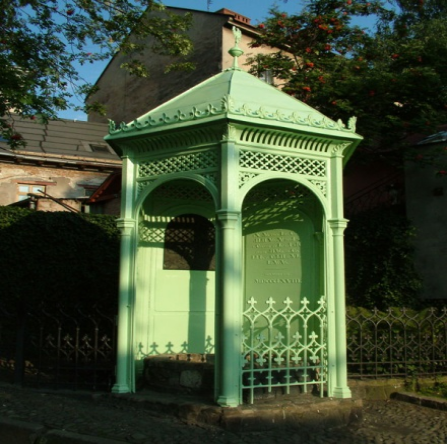
The oldest continuously operating museum in Central Europe is located in Cieszyn. It was founded by priest Leopold Jan Szersznik, an outstanding Jesuit, versatile scholar and teacher, opened in 1802. Apart from art and history monuments, its collection contained a large natural collection (specimens of fauna and flora, fossils, minerals), cartographic (globes, maps and plans ), scientific aids (geometric, astronomical and astrological instruments), peculiarities (reliquaries, exotic tools and instruments). The birth record in Poland is matched only by the Czartoryski Museum in Puławy, opened in 1801, but having a decades-long break in operation and now located
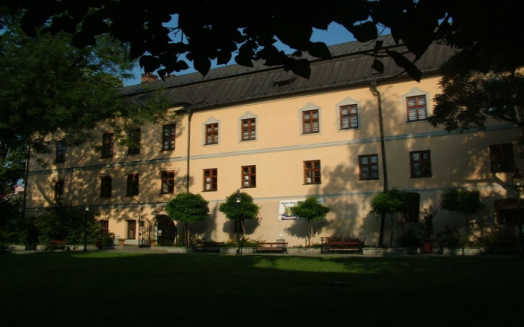
-Romanesque St. Nicholas' Chapel (Kaplica św. Mikołaja, a rotunda from the 11th century)
-Remnants of the Piast dynasty castle
-Piast Castle Tower (Wieża Piastowska, mostly 14th century)
-Gothic St. Mary Magdalene Church (Kościół Marii Magdaleny, 13th century)
-Old Town Square (Rynek)
-bourgeoisie houses (15th–19th centuries)
-Town Hall (Ratusz, early 19th century)
-Former minting house (18th century)
-Lutheran Church of Jesus (18th century)
-Museum of Cieszyn Silesia in the former Larisch family palace (Pałac Laryszów, Muzeum Śląska Cieszyńskiego, the first museum in Poland)
-Castle Brewery (Browar Zamkowy, 1846)
-Habsburg Palace in Cieszyn
-Bonifraters Monastery (18th century)
-The protestant Church of Jesus (Kościół Jezusowy), with a baroque tower and statues of the Four Evangelists above the altar that liven up the plain interior.
Ⅵ.History and Culture
-The area has been populated by Slavic peoples since at least the 7th century. According to legend, in 810 three sons of a prince – Bolko, Leszko and Cieszko, met here after a long pilgrimage, found a spring, and decided to found a new settlement. They called it Cieszyn, from the words cieszym się ("I'm happy"). This well can be found at ulica Trzech Braci ("Three Brothers Street"), just west of the town square.
-The District Court of Cieszyn built in 1905, an ideal example of the town's long prosperous history and its impact on architecture
-The town was the capital of the Duchy of Teschen since 1290, which was ruled by Piast dynasty until 1653 and by the Habsburg Dynasty of Austria until 1918. It was in Teschen that Maria Theresa and Frederick II on in May 1779 signed the Teschen Peace Treaty, which put an end to the War of the Bavarian Succession. In the 19th century Teschen was known for its ethnic, religious and cultural diversity, containing mostly German, Polish, Jewish and Czech communities. There was also a small Hungarian community in the town consisting mostly of officers and clerks.
-The town was divided in July 1920, by the Spa Conference, a body formed by the Versailles Treaty, leaving a Polish minority on the Czechoslovak side. Its smaller western suburbs became what is now the town of Český Těšín in the Czech Republic. During the interwar period two villages were merged into Cieszyn: Błogocice in 1923 and Bobrek in 1932. After 1920 many ethnic Germans left the town, while many Poles from the Czechoslovakian part of the region moved in. According to the Polish census of 1921, Cieszyn had 15,268 inhabitants, of whom 9,241 (60.5%) were Poles, 4,777 (31.2%) were Germans, 1014 (6.6%) were Jews, and 195 (1.3%) were Czechs. The census from 1931 indicated 14,707 inhabitants, of whom 12,145 (82.7%) were Poles, while the rest consisted mostly of Germans and Jews (in 1937 estimated to be 12 and 8% respectively).
-Cieszyn and Český Těšín were merged again in October 1938 when Poland annexed the Zaolzie area together with Český Těšín. In 1939 Cieszyn Silesia was occupied by German forces and during World War II it was part of Nazi Germany. Almost the entire Jewish community was murdered by the Nazis.
-After World War II, the border between Poland and Czechoslovakia was restored to that of 1920. Most Germans fled or were expelled and were replaced with Poles expelled from the Polish areas annexed by the Soviet Union. Signs of the former German presence in the town were removed by a special committee.
-On 19 July 1970, five firefighters from Cieszyn died when a bridge they were on fell into the Olza River, due to heavy flooding. In 1977, Boguszowice, Gułdowy, Kalembice, Krasna, Mnisztwo, Pastwiska were amalgamated with Cieszyn and Marklowice.
Ⅶ.Other Information
-Cieszyn is a border town in southern Poland on the east bank of the Olza River, and the administrative seat of Cieszyn County, Silesian Voivodeship. The town has 34,513 inhabitants (as of 2019), and lies opposite Český Těšín in the Czech Republic's Karviná District, Moravian-Silesian Region. Both towns belonged to the historical region of Austrian Silesia and formerly as one town composed the capital of the region of Cieszyn Silesia.
Ⅷ.Contact Information
Government
Mayor Gabriela Staszkiewicz
Town Hall in Cieszyn ul. Rynek 1,43-400 Cieszyn
Tel.: +48 33 47 94 200
Fax: +48 33 47 94 303
E-mail: uwad@um.cieszyn.pl
NIP : 5480018504
REGON : 000515709
TERRITORIAL CODE : 2403011
